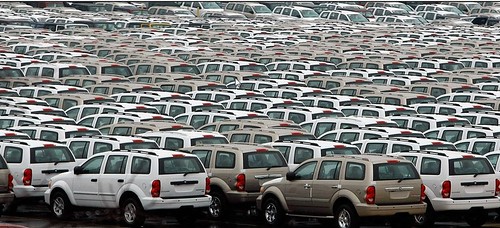The driving mentality

Dodge SUVs sit parked in the Atlantic Marine Terminal at the port of Baltimore February 18, 2009 in Baltimore, Maryland. As the worldwide economic downturn persists and automobile sales continue to slow, more than 57,000 new automobiles sit idle in the port of Maryland. The state of Maryland recently paid $5.26 million for almost 15 acres of additional car storage space near the port, freeing space for more cargo. (Chip Somodevilla/Getty Images)
The back and forth discussion about whether or not (not!) DC should subsidize gas stations (although in talking about this with a colleague I was reminded that Councilman Harry Thomas is now supported by ex-Councilmember John Ray, who is a sometime lobbyist for gas station interests), and Councilmember Thomas' earlier derisive comments about Mayor Fenty's Smart Car (see "st. martin's apartments groundbreaking ceremony" from Bloomingdale (for Now)), reminded me of this New Yorker article by Malcolm Gladwell about SUVs, "Big and Bad: How the S.U.V. ran over automotive safety," and this quote:
As Keith Bradsher writes in "High and Mighty"—perhaps the most important book about Detroit since Ralph Nader's "Unsafe at Any Speed"—what consumers said was "If the vehicle is up high, it's easier to see if something is hiding underneath or lurking behind it. " Bradsher brilliantly captures the mixture of bafflement and contempt that many auto executives feel toward the customers who buy their S.U.V.s. Fred J. Schaafsma, a top engineer for General Motors, says, "Sport-utility owners tend to be more like 'I wonder how people view me,' and are more willing to trade off flexibility or functionality to get that. " According to Bradsher, internal industry market research concluded that S.U.V.s tend to be bought by people who are insecure, vain, self-centered, and self-absorbed, who are frequently nervous about their marriages, and who lack confidence in their driving skills. Ford's S.U.V. designers took their cues from seeing "fashionably dressed women wearing hiking boots or even work boots while walking through expensive malls. " Toyota's top marketing executive in the United States, Bradsher writes, loves to tell the story of how at a focus group in Los Angeles "an elegant woman in the group said that she needed her full-sized Lexus LX 470 to drive up over the curb and onto lawns to park at large parties in Beverly Hills. " One of Ford's senior marketing executives was even blunter: "The only time those S.U.V.s are going to be off-road is when they miss the driveway at 3 a.m."
And another quote from Tony Hiss' book Experience of Place. I don't have the book handy, but he writes about how being in an automobile disconnects drivers from having to have a sense of responsibility for the space outside of the automobile.
Labels: car culture and automobility



0 Comments:
Post a Comment
<< Home